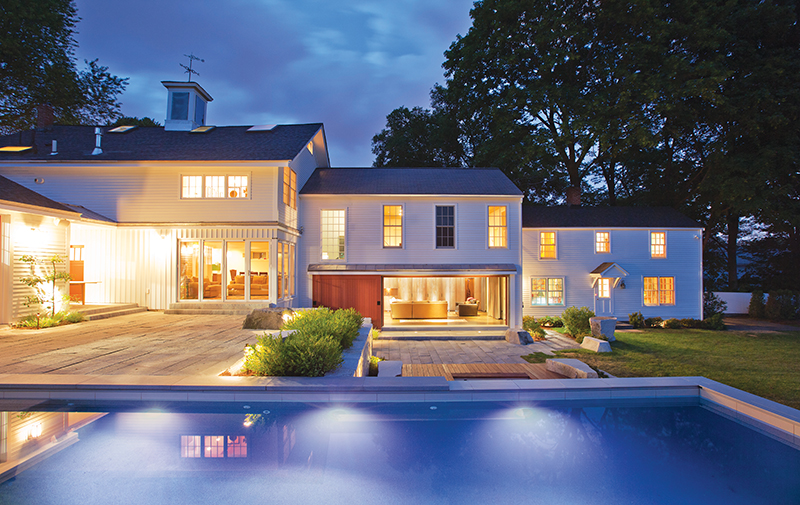It’s easy to imagine soft-spoken Peter White discussing the wealth of possibilities with a new client—quiet enthusiasm underlying his words. One of these three principals behind Zen Associates, Inc., the landscape architect’s gentle demeanor belies the grandeaur of his firm’s talent. With unwavering modesty White describes their work in its simplest terms.
“We design and build creative landscape projects that reflect our clients’ goals and personalities.” While true, his description only scratches the surface of what ZEN Associates is all about. Founded in 1980 and headquartered in Woburn, the design/build firm is revered for its ability to mold landscapes into divinely harmonious nodes, corridors, and tertiary spaces that tie seamlessly to a home’s interiors. White and his partners believe a site’s landform, architecture, and environment, and the client’s lifestyle are all inextricably linked. Working with that theory always at the fore, they create spaces that engage the senses, heighten awareness, and evoke an aesthetic and emotional response. The results are simultaneously natural and cutting edge. It is the artful synthesis of form and function that makes ZEN’s designs both memorable and livable.
“What we constantly think about,” explains White, “is how to integrate the interior and the exterior spaces and how to break down the [barrier] that so often separates us by glass or walls. We try to first make the space larger by bringing the inside out or the outside in.”
Though White and his team adhere to industry regulations and standards, they do not get “caught up in symme- try or axes or mathematical formulas.”
There are symmetrical aspects and axial corridors in their designs, but the focus is on natural forms. “The house is the manmade, geometric component,” says White. And it is the element around which they orchestrate the landscape—always thinking about how to bring together nature’s loose contours with architecture’s strict lines. White gives the example of a kitchen with a simple rectangular deck that juts into the landscape: They might bring big boulders into the deck to break up its lines and/or extend the deck so far out that it penetrates curvaceous bed borders. “It’s a nice way to bring nature into that built space,” he notes.
From residential interiors to corporate offices to restaurants and private function rooms, ZEN Associates is accustomed to designing all manner of indoor and outdoor spaces. With projects up and down the eastern seaboard, west to the Rockies, and overseas, its 65 employees comprise a sizeable construction crew, plus landscape architecture, interior design, project management, and horticulture maintenance departments. In addition, a nine-member construction team works out of a small Washington, D.C. branch. In Woburn, all departments regularly convene to create the ZEN Associates aesthetic. One side of the office is given over to the interior designers and landscape architects, the other half houses the construction crew, and smack in the middle sits the primary conference room. “Nearly every day, and absolutely on every project, the construction and design [departments] come together and talk about projects so we can build things that are creative, on time, within budget, and really well built,” explains White.
|
|
This is one of many things that distinguish ZEN Associates from other land- scape architecture firms. “We build the projects we design because we find it to be a better process than separating designer and builder,” notes White. “The idea and the responsibility should walk hand in hand. When delivering a project to a client, we want to be responsible for everything.”
Nearly 70 percent of their work is residential and chiefly focused on large to medium-sized projects in which clients are putting an addition onto the house, renovating a site, or investing in a new build. Though their commercial work makes up just 30 percent of the business, it includes large-scale commissions like a Japanese-inspired courtyard garden for the Asiatic department at Amherst College; the Peace Bell Garden for the United Nations Visitor Centre in New York; and the renovation of gardens once belonging to Marjorie Merriweather Post—heiress to the Post cereal fortune—at the renowned Hillwood Estate, Museum, and Gardens in Washington, D.C. Currently, projects in Sweden and London keep them busy overseas. On the North Shore, almost all of their work is residential, though they have put in a number of healing gardens for area hospitals.
No matter the site, stonework figures largely into ZEN’s landscapes. “New Englanders have a romantic passion for stone walls,” notes White. “Most people don’t know why, they just know they love that look.” They are, of course, easily found in rural farm settings, but they have begun to appear more and more in contemporary suburban developments and even in cities, where buildings are complemented by a modern application of fieldstone. “It’s interesting that we have such a passion for stone walls,” notes White. “They don’t really have a long history here. Thoreau and Frost wrote about them and [now] we are all attached to them.”
To appeal to that innate sentiment, ZEN distributes stone throughout a landscape in any number of ways—as furniture, for structure, to define space and function. “We love to have [people] put their hands on the boulders instead of hiding them in the beds,” says White. They have been known to place enormous boulders next to formal dining rooms “to lighten things up.” White and his team believe “there’s kind of a spirit there,” and it can be a playful spirit. For clients with young kids, they suggest using boulders to invite game playing. Often, those clients express concerns around safety. White responds by saying, “These are elements of play. [Children] can learn a lot about balance, caution, and confidence.”
In terms of sourcing stone, they choose from local farm fields and quarries or have it shipped in. According to White, “First, we determine the role of the stone, then figure out, aesthetically, the vocabulary for the material.” They may select granite, limestone, basalt, or blasted quarry stone, depending on the proposed function and desired statement. “We’ll use any type of stone; most important is that it is right for the project.”
With four horticulturists and two arborists on staff, it is clear ZEN cares about its landscapes’ long-term health. “We are heavy into plant knowledge—both in the design and the installation in the field,” he notes. The mantra of all knowledgeable gardeners is “right plant, right place”—something White and his associates consider crucial. The fact that they are willing to spend up to nine months amending a site’s soil speaks volumes about their commitment to installing gardens designed to thrive. White talks about the quality, texture, and drainage of soil like a true plantsman—a rare characteristic among landscape architects. It is yet another virtue separating ZEN Associates from other landscape architecture firms, many of which are very practiced at design and placing plants on layouts but lack the deeper understanding of their cultural requirements.Since the firm’s inception, White and his partners, Shinichiro Abe and Maho Abe, have slowly moved away from being a strictly Japanese design/build firm to a more modern design/ build firm with roots in the Japanese design aesthetic. New England’s climate is very similar to that of southern Japan, so plants like maples, azaleas, rhododendrons, and viburnums are often seen in their plantings. “We do lots of scene plantings,” explains White. “Maybe we’ll use 90 percent grasses for one project, while another might be mostly conifers. We stay away from using the same plant list for every project.”
“When the plants go in, they all look very good, but it is about the test of time,” says White. To ensure their plantings ace that test, the maintenance crew returns months after installation to inspect plants and confirm they have “done a good job aligning plants with the existing site’s soil.” White notes, “We pay a lot of attention to that, even when we are buying plants, because we buy from all around the Northeast, from Michigan, all the way down to the Carolinas.” Giving thought to where plants originate matters significantly in terms of their survival—if they come from the South’s clay-heavy soil and are planted in New England’s gravelly soil, measures must be taken and amendments made. ZEN takes those measures.
Along with stonework, sustainability factors heavily into the ZEN approach. They choose noninvasive plant species, use organic materials, and opt for Integrated Pest Management techniques over chemical sprays. “We encourage clients to choose a different way that may take a little more effort,” explains White. They also make clear the importance of not overwatering. Even in the case of clients who want a pristine “Scott” lawn, “there is an opportunity to talk with them about cutting down on the watering because over saturation leaches nutrients down out of the soil.” He spells out how to get that hyper-manicured look without chemicals and excessive watering.
Despite such efforts, some projects inevitably leave a large carbon footprint. Operating expenses, water usage, electricity requirements, and “the negative landscape,” which White describes as the “wiping out of something beautiful to put in something beautiful,” all take a toll on the environment. These things are discussed up front; he and his partners talk about preservation practices and help set expectations. Some clients are willing to compromise on what they want if they understand the value of what they have.
Initial discussions also include talk around the style of the landscape desired, the big-picture opportunities for what can be done with a site, and eventually the technical end of things, which includes soil quality and plant selection. “But first,” says White, “what we want to talk about is the spirit and artistry of the space in terms of daily viewing and daily living.” They are not quick to start construction. “The most important thing to us is designing a space or project or site that the client owns, that is about them and reflects what they want.” Toward that end, they spend a lot of time listening and just as much time sharing ideas. “We also spend a lot of time kind of stewarding their thought processes to [guide] them towards doing something thoughtful, logical, and beautiful.”
Currently, the ZEN group has two North Shore projects underway. In Manchester-by-the-Sea, they are collaborating with a design team that includes Adolfo Perez and Meichi Peng on behalf of a client whose ultra-modern home is perched on a ledge abutting the ocean and nestled into a noteworthy selection of old-growth trees. “We’ve gone a great distance to preserve and expose a natural, sort of masculine ledge—it’s a quintessential North Shore coastline.” They have also recently broken ground on a Swampscott site where they are installing a stream that starts at the house and cascades down in a series of waterfalls to terminate in a large pond peering out toward the ocean. White is especially proud of a path beneath the main waterfall that enables people to walk under a canopy of water. “We love to chat with people about their projects,” he enthuses. “It’s a big investment, and it’s important to find a design/build firm that you can have a good relationship with from the beginning—and that is creative and experienced.” ZEN Associates is pre- cisely that sort of firm. zenassociates.com




